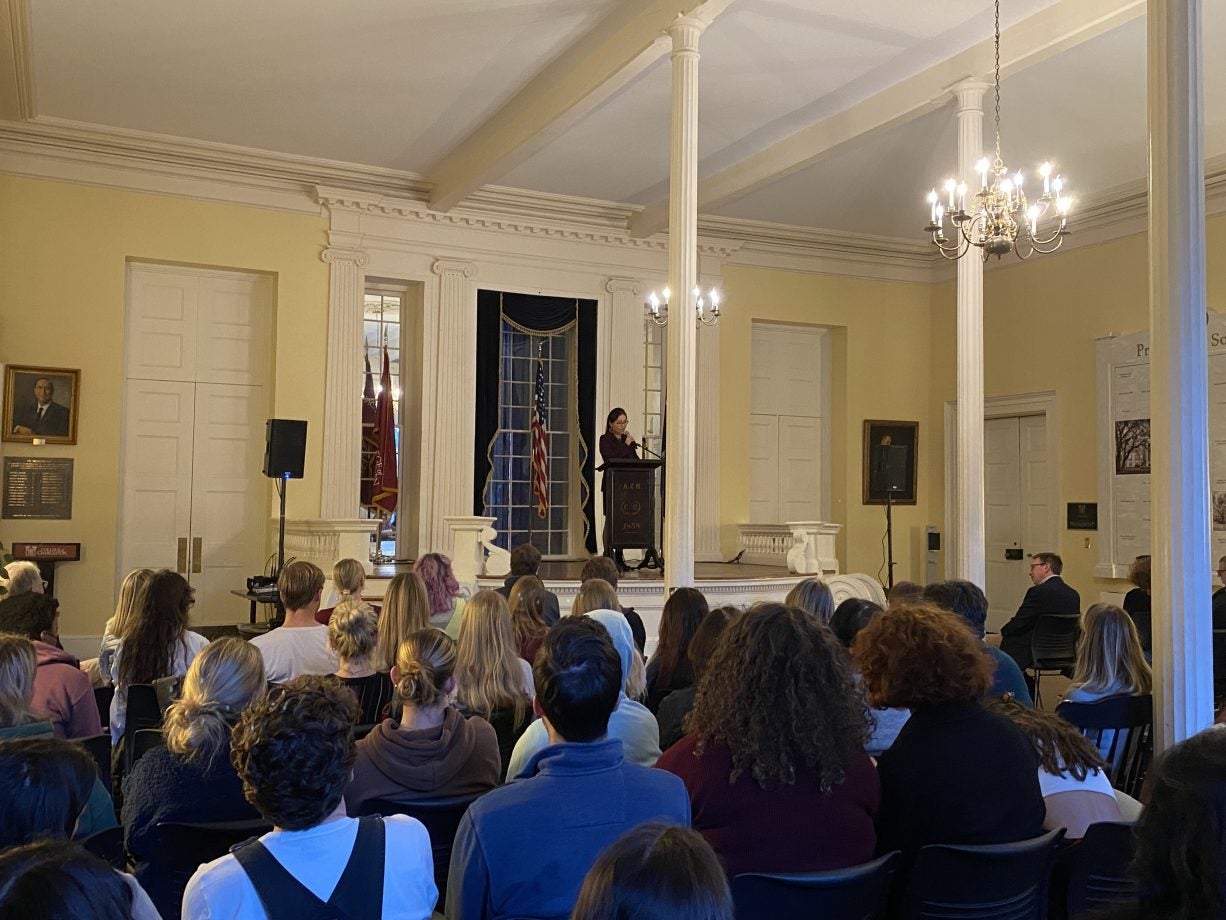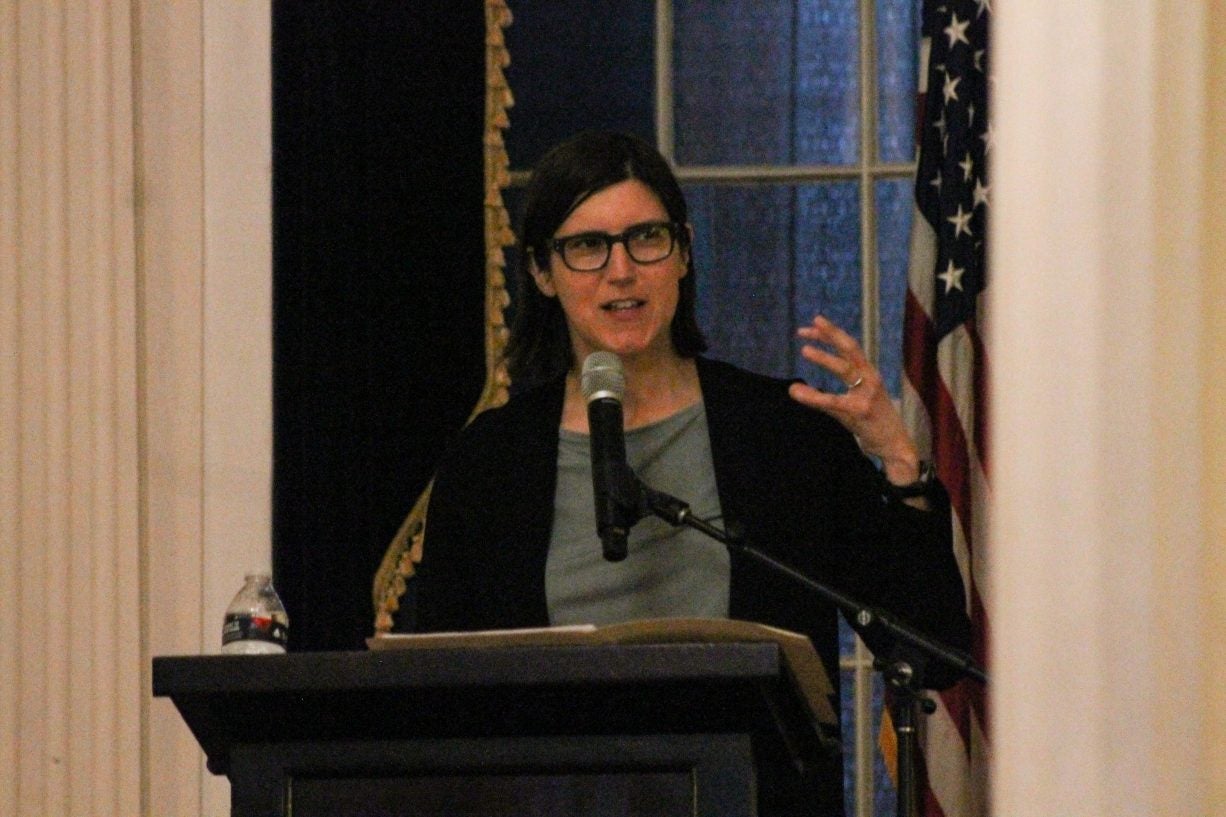
Curtis Sittenfeld Reads at CofC
March 28, 2023 | blog, readings

Hanna Reynditskiy (Fiction, ’24) & Emilie Ross (Fiction, ’24)

On the evening of March 14th, Curtis Sittenfeld read to a full house at Randolph Hall, Alumni Hall. The audience buzzed with excitement, but before Sittenfeld stepped up to the podium to read, MFA director, Anthony Varallo, greeted the audience, presented an overview of Sittenfeld’s work, and introduced Dorothea Benton Frank Fellow, Kangkang Kovacs. Kangkang discussed Sittenfeld’s 2020 novel, Rodham, a reimagining of Hillary Clinton’s life had she remained as Hilary Rodham instead, and the ways in which it acts as a “thoughtful defiance to cynicism.” She went on to discuss the emotional authenticity of the text which rings true for the rest of Sittenfeld’s work.
After a round of applause, Sittenfeld took the stage. She then read from her short story, “Show Don’t Tell,” which appeared in a 2017 issue of The New Yorker. She started off by saying that it doesn’t ever say that it’s set in an MFA program, “but it’s definitely set in an MFA program.”
“I think I tried to write a version of this story in about 2004 or 5,” Sittenfeld said, but nothing came of it. Years went by and she got into a groove of writing novels instead of short stories. Then at one point, she somehow uncovered the story, dusted it off, and got so embarrassed with herself, alone, in her small office, that in her words, “it almost burned my eyeballs.” But there was one part in the story––“a party that all these grad students attend, and three of the grad students sort of meet in the middle and give like a five-minute hug”––and the emotional turmoil of those characters meeting up again struck her, and she felt compelled to visit the piece again. She rewrote it, but all in all, this one little piece took her about 13 years to write. Then, of course, it was published in The New Yorker.

On the topic of her forthcoming book, Romantic Comedy, Sittenfeld said, “The short way of explaining this book is that I wrote a novel about Pete Davidson.” Sittenfeld warned us that when you write a book, you become what she says “a magnet for people’s confessions about that topic.” When she wrote Eligible, 2016, for example, she became swamped with people telling her that they reread Pride and Prejudice annually or that, would you know it, they had never in their whole lives picked up a Jane Austen novel. Now, with Romantic Comedy, people are responding to her Tweets confessionally, letting her know that they personally never understood the allure of Pete Davidson, the poster boy for the talented but “ordinary-looking, or mortal,” male SNL writer getting together with a gorgeous, younger musical guest or guest host after the show.
Sittenfeld’s Romantic Comedy turns this phenomenon on its head––well, gender-wise at least. Fictional comedy sketch writer for the fictional show, The Night Owls (TNO), Sally Milz, is heartbroken and ordinary and hates the pattern of regular-looking male sketch writers on her show getting together with goddess-like women guest stars. There would never be a super-hot male guest who would ever get together with someone like her.
Sittenfeld gave us a rundown of how the idea started with getting her kids into Saturday Night Live during Covid, and when her kids, who may or may not be too young for SNL, started to notice the Pete Davidson effect, she felt that if there was a screenplay where the woman was the ordinary writer, she would happily watch it. Then, as Sittenfeld said through audience laughter, “a few months passed and I thought, ‘Oh it shouldn’t be a screenplay. It should be a novel, and the someone who should write it is… is me!”
Romantic Comedy is slated for release on April 4th.
After Sittenfeld’s reading, the floor was opened to questions. Rachael Mockalis, a CofC MFA student, led with an intriguing question. In Sittenfeld’s short story collection, I Think It, You Say It, the stories seem to be based around false perceptions, and Rachael brought this to attention. She asked whether Sittenfeld had done this purposefully and if the answer was yes, what sparked the intention. As it turns out, it was intentional on Sittenfeld’s part: she is drawn to characters with false perceptions. “The particular kind of character that I’m drawn to writing about is a person who is not brilliant or a genius, but is reasonably intelligent and turns out to be wrong,” Sittenfeld said. This kind of character is very prominent in her story collection, and Sittenfeld explained that she is, “drawn to that structure over and over.”
Intrigued further by her characters, another student asked how Sittenfeld goes about writing her characters. Sittenfeld explained that her writing professor gave her and her class a good piece of writing advice that she uses to this day. She said, “When you’re writing a character, think of who the character most physically resembles, like a celebrity or a childhood neighbor, then think of who the character’s personality most resembles, which is probably a different physicality than personality.” By connecting your character to a real person and thinking in terms of specifics—for example, what kind of snack would this character eat or what kind of gesture does the real person have that resembles your character?—Sittenfeld believes a writer may achieve a deeper realism with their characters.
CofC MFA student, Campbell Sullivan, asked if Sittenfeld has any sort of writing rituals or creature comforts at her desk and whether these acts or objects helped with motivation. “Every day that I write, I write down the date, the time that I start and then the page that I start on,” Sittenfeld said. “It’s a marker of my progress. It’s an encouragement that I’m giving myself.” Another student wanted to know what keeps Sittenfeld moving forward. Though Sittenfeld is at the point in her career where she can make contracts with publishers before having a manuscript, she said having a community of writers helps her with her personal motivation. Declaring her goals to her writing community and keeping herself accountable to those goals has kept her on track.
“For those of you in the MFA program,” she said, “if you can find your readers, people who give you valuable feedback, then you’ve found a precious thing.”
